| |
EDAKKEL CAVES IN KERALA INDIA HAS 8,000 YEAR OLD PETROGLYPHS & ARTIFACTS FROM 10,000 YEAR INDUS VALLEY CIVILIZATION....proving "Aryans" coming to Indi
Posted by Champaklal Dajibhai Mistry on May 14, 2010 |

Edakkal Caves in Kerala is located at 4,000 feet above sea level
on
the top of Mount Ambukuthi 10 kilometers from Sultanbathery in Wayanad
district
has world's Richest
Petroglyphs (Pictographic) Gallery of its kind
with petroglyphs done as early as 4000 years and as old as 8,000 years...
These petroglyphs are believed to have been
created by highly civilized prehistoric
people.....
The Edakkal cave site is on an ancient route connecting the high ranges
of Mysore to the ports of Malabar.

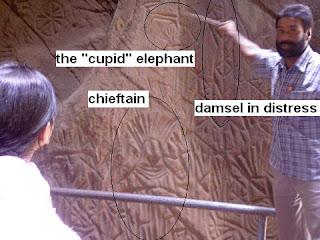 |
Stone age
Petroglyphs
including human and animal figures carvings
dating back to about 6000 BC in Edakkal Caves in Kerala, India
|
.......today's new story.....
......2000 bc Harappan culture
`signatures'
found in Edakkal caves IN Kerala, INDIA......
(From:
a href="http://news.in.msn.com/national/article.aspx?cp-documentid=3251075">
MSN.NEWS:
September 29, 2009: C S Narayanan Kutty, Press Trust Of IndiaKozhikode)
|
A rock engraving, indicating clear remnants of Harappan culture,
has been found in the Edakkal caves in neighbouring Wayanad
district, linking the Indus Valley civilization with South
India.
"There had been indications of remnants akin to the Indus Valley
civilization in Karnataka and Tamil Nadu, but these new findings
give credence to the fact that the Harappan civilization had its
presence in the region too and could trace the history of Kerala
even beyond the Iron Age," historian M R Raghava Varier said.
The unique symbols integral to the Indus Valley culture
traced in Harappa and Mohanjedaro region that stretched up to
Pakistan, were found inside the caves during recent excavations
by the State Archaeological Department.
Of the identified 429 signs, "a man with jar cup", a symbol
unique to the Indus civilization and other compound letters
testified to remnants of the Harappan culture, spanning from
2300 BC to 1700 BC, in South India, Varier, who led the
excavation at the caves told PTI.
The "man-with-the-jar" symbol, an integral remnant commonly
traced in parts where the Indus Valley civilization existed, has
even more similarities than those traced in Karnataka and Tamil
Nadu, he said.
The 'man-with-the-jar' has been a distinct motif of the Indus
valley symbols. The Edakkal engraving has retained its unique
style as the engraver tried to attain a two-dimensional human
figure, Varier said.
|
This could be attributed to the
transformation from the distinct symbols of the Indus Valley
civilization that could have taken place in due course of time,
he said.
The 'jar' is more or less same as those in Indus ligature.
But the human figure is a little different.
"These symbols form part of compound letters similar to
scripts and no concerted efforts appear to have been made in the
past to decipher them, with a lone exception by Iravatham
Mahadevan (a scholar on the Indus valley civilization), who
could gather valuable ideas from such letters," he said.
"The discovery of the symbols are akin to that of the Harappan
civilization having predominantly Dravidian culture and
testimony to the fact that cultural diffusion could take place.
It is wrong to presume that the Indus culture disappeared into
thin air," Varier said.
The symbols and pictographs found in the Edakkal cave were
subjected to study for the first time in 1901 by Fawsette, a
police official of the then Malabar district.
Later, Varier, along with noted history scholar Rajan Gurukkal
carried out further studies, which testified that the caves had
remnants up to the Iron Age.
The new findings could take the history of Edakkal and Kerala even
beyond and throw more light into the culture of the region,
Varier added.
........SHARE IT WITH OTHERS.... |
|
......EXPERIENCE PERSONAL VISIT ACCOUNTS OF
TWO
LEVEL EDAKKAL CAVES
CREATED 8000 YEARS AGO....
and
......the original tribal inhabitants
of the Waynard District still living their tribal culture....
 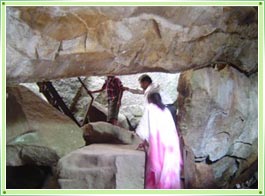
|
(from
bharatonline.com)
The Edakkal Caves in Wayanad are
magnificent formations of nature. The word 'Edakkal' itself means 'a stone in
between'. The structure of these caves is truly extraordinary as a big boulder
balances itself on two relatively smaller boulders, thus forming the truly
fascinating Edakkal Caves of Kerala. These caves are a very popular tourist
attraction of Wayanad. The cave has two levels inside that can be entered
through an entrance that is merely 5 feet in height.
The lower chamber is around 18 feet long and 10
feet high. A small passage from there leads to the upper chamber that is around
95 feet long and 18 feet high. This truly magnificent structure is a storehouse
of pre-historic art forms. These etchings and carvings on the walls of the caves
are truly fascinating as they date back to almost 5000 years. This attracts
historians and archaeologists from all over the world. The Edakkal Caves have
been the cradle of human civilization at different stages in history.
(from
hinduonnet.com): By Manu Remakanth
The sun casts its shadow as the path gradually climbs up. To hike up 4,000
feet above sea level is no easy task. But to reach the Edakkal caves, one of the
most important historical sites in India, one has to be unrelenting. The dry
crunchy leaves under your feet, the twitter of birds, the early morning rays and
chill, make the trudge to the top of Mount Ambukuthi, an exhilarating one.
The last pull to the top is tiring though as you have to squeeze through gaps in
rocks to reach a small dark mouth of a cavern. Upon reaching the entrance to the
cave, the small gap gives you the queasy feeling that you will have to be on all
fours throughout the time spent in the cave. However, your fears come to a rest
upon entering the cave. The air is crisp and the cave is spacious enough for you
to stand and look around.
The dampness around is the first thing that strikes you. A trickling sound shows
a perennial stream. At our guide, Wilson's insistence, we taste the water.
Refreshing. Revitalized, we continue our long haul up to the second cave, our
destination. Even with the flight of stairs cut into the rocks, we found it
tough. Wilson continued to inspire us with stories of how octogenarians' made it
to the top. We finally make it to the top and to the opening of a cave. The
unassuming entrance leads us to an enthralling sight.
An enormous cave, it is surprisingly bright in here. I soon learn how Edakkal
(its literal meaning is `the stone in the middle'). A huge boulder acts as the
roof of the cave.
"The rocks might have been split asunder in pre historic times during an
earthquake or landslip and the boulder might have fallen then," reasons Wilson.
For the tribals who lived in the Neolithic age, the cave was their abode. They
drew their dreams and visions on the rocky walls using sharp stone tools.
The cave was discovered in 1890 when Fred-Fawcett, the then superintendent of
police of the Malabar District, stumbled upon it. He identified the site as the
abode of Neolithic people.
The carvings on the walls show how a chief clad in arms led the people and how
they hunted for animals.
Our ancestors apparently travelled in carts as depicted in a drawing of a woman
in a cart.
To prevent visitors from doing damage to the carvings, an iron rod separates
them from the wall.
Outside the cave, one can see the rolling mountains under the deep blue sky.
Down below, a stream gurgles down the rocks. I absorb the scenic beauty and
imagine myself as the chief shown on the walls, surveying his small empire and
on the lookout for enemies. A trip to the past.
(From:
Kerala Holiday
)
Once you enter the place, you are likely to be overwhelmed by the cave drawings,
ancient scripts on stone, pictorial figures of humans and animals as well as
profusion of the symbols within. These pictures are very rare and point towards
the existence of the stone age man.
There are other legends associated with the place as well which say that the
arrows fired by Lava and Kusha, the two sons of Sri Ram, were the cause of the
formation of the cave.
From:
UNNIMAYA GARDENS :
 Know
the Tribal inhabitants in waynard district, the location of edakkal
caves:: Know
the Tribal inhabitants in waynard district, the location of edakkal
caves::
It is quite possible that the tribal
habitants of Wayland district could have genetic and cultural lifestyle
connection with the creators of Edakkal caves who seem to have been highly
civilized pre-historical peoples. Wayanad offers its
visitors a unique opportunity to view this tribal life.
The Paniyas, Kurichias,
Kurumas and the Kattunaykas are some of the oldest inhabitants of these jungles.
Visit one of their villages, taste their food and drinks, watch their art forms,
rituals and festivals, and you'll see life - as it was many generations ago.
Vattakkali and Kooliyattam of the Paniyar tribe, Gadhika of Adiyar tribe,
Kolkali of the Kurumars and Nellukuthupattu of the Kurichiyas are the major
tribal arts in Wayanad.
|
SOME MORE TRUTH
ON
MIS-INFORMATION TO DATE ON
"ARYANS" COMING TO INDIAN SUBCONTINENT.....
|
PVAF is publishing this news as part of its continual search for and
sharing with humanity
the True Knowledge (bRH`m-GNaan)
of True Reality (Creator
bRH`m)......This news story should be read with
the recent news story on this web page titled
"PEOPLES OF INDIA ARE ORIGINAL PEOPLES OF
THE LAND.....Aryan ancestry of Indian people is a myth....say Harvard
Medical School Study....." (click
here
to read this false Aryan ancestry
story)
By reading as noted
above...one would realize that there is finally mounting evidence
against the misinformation spread by 19th and 20th century historians
about the invading Aryan origin of peoples of Indian
subcontinent....
It appears now the human race called
"Aryan"
does not even exist....and thus the entire corpus of
vED = SCIENCES OF LIFE AND
CREATION that is extant in India in
sNskRUt language
was always in the Indian subcontinent and not imported to Indian
sub-continent by so called
"Aryans".... |
......NOW KEEP
LEARNING MORE ON
EDAKKAL CAVES
AND ITS RELATION TO
THE INDUS VALLEY CIVILIZATION
.....which is the oldest known civilization in our world today....
......a civilization of a lifestyle with
highly evolved life sciences, building sciences and
socio-economic cultural sophistication...
|
Please click on the next line to go to the next page of this news
story with another news report dated April 3, 2008 about the resumption
of excavating the Edakkal Caves/strong> after
114 years of its discovery .....and information on
Edakkal Caves
location and contents with photos of the caves and the 8000 year old
petroglyphs on the cave walls....
......And learn more the currently available knowledge on the
Indus Valley
Civilization which is
over
10,000 year old/span> & in Indian sub-continent....
Indus
Valley Civilization is the oldest
known civilization founded on life sciences of
vED...with
an amazing new facts that the
Indus
Valley Civilization has not disappeared as believed by
19th and 20th century western archeologists ....but evolved a
natural evolution for
the
vEDik
time era called
kli-yug which started about 5111 years
ago...The lifestyle of humans in kli-yug is described in all of the
18 puraaAN sNskRUt texts
of
vED sciences
and is self-evidently true as
kli-yug evolves to its 432,000 year span.... |
|
..........please HAVE A
PHOTO TOUR
OF
Edakkal
caves..... |
Above and below Photos: Entrance to Edakkal Caves: This is a
crevice for about 96 ft in length and 22 ft width. A fissure was created
due to a rock splitting due to natural weathering. The depth of the
crevice and the fissure is nearly 30 ft which gives an appearance of a
cave to any observer.
|
AND now read APRIL 2008 REPORT ONbr />
re-excavatION OF EDAKKAL CAVES
after 114 years
(From:
TOP
NEWS:
Submitted by Mohit Joshi on Thursday, April 3, 2000)
|
A re-excavation, conducted after 114 years, by the Kerala State
Archeology Department has unearthed 40 odd engravings, artifacts of
Neolithic period and some tools used for chiseling these huge engravings
at the renowned Edakkal Caves.br />
The Edakkal Caves are situated at Ambukuthi mountain ranges near
Ambalavayal, about 12 km from Sulthan Bathery in Wayanad district of
Kerala.
The size of each engraving in the lower part ranges from two feet and
the upper part contains engravings of more than six feet in size.
The stone carvings inside the caves shed light on the life and culture
of the ancient cavemen who lived in the Neolithic era or New Stone Age,
from 4000 BC to 1700 BC.
After conducting trail digs in December last year the department decided
to go for a full fledged digging on March 14 to clean and re-excavate
the caves due to sediment-metal and dust deposits up to 90 centimeters
deep.
The entire operation was led by Hemachandran, Superintending
Archaeologist and D. Mohanan, Excavation officer of the states
Archaeology Department.
Hemachandran said: "During the re-excavation we have got many important
artifacts used by these people including a round stone tool used for
chiseling and this is a major finding as in earlier trials we did not
get artifacts and this will definitely help us in studying more about
the engravings and its creators".
A detailed report on the analysis would be available in a few months,
Hemachandran said.
Archeologists believe that this is a major finding after 1894, which
will help to assess their antiquity and significance to the drawings
that already exist in the cave.br />
FFred Fawcett, Superintendent of Police of the then Malabar District,
discovered the Edakkal Caves in 1890. (ANI) |
........AND CONINUE TO LEARN MORE ABOUT
EDAKKAL
CAVES
IN PHOTOS OF THE WALL WRITINGS
AND ART WORK OF
THE CREATORS OF THE EDAKKAL CAVES....
......PHOTOS WORTHS THOUSAND WORDS
WHICH WE CANNOT YET UNDERSTAND..... |
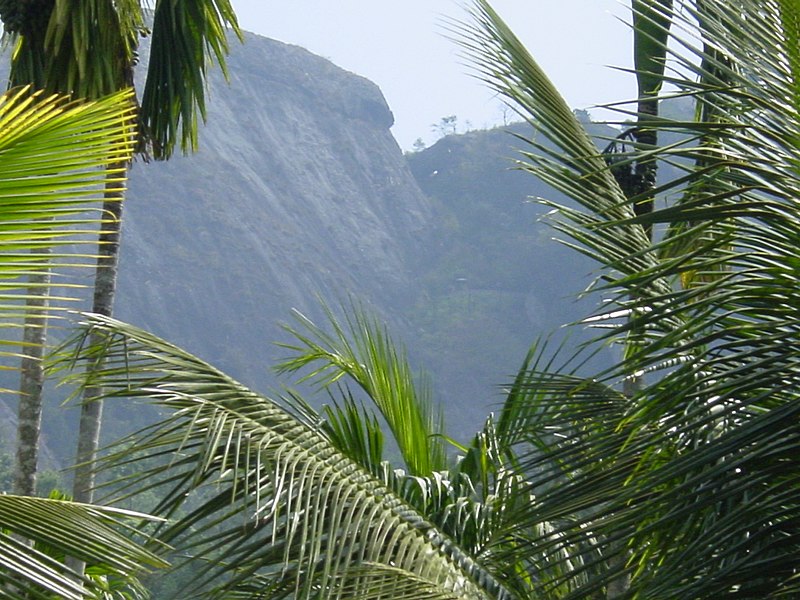
.strong>...Look closely at the top of ravine and see light shining
through Edakkal caves....
|
Edakkal Caves In Kerala, India
from
Wikipedia,
the free encyclopedia
Edakkal Caves are two natural caves located 1000 metres
high on
Ambukutty Mala 25 km from
Kalpetta in the
Wayanad district of
Kerala
in India's
Western Ghats. They lie on an ancient trade route connecting the
high mountains of Mysore to the
Malabar coast ports. Inside the caves are pictorical writings
believed to be from
neolithic man, evidence of the presence of a prehistoric
civilisation existing in this region. Such
stone age carvings are very rare and these are the only known
examples in southern India.[1]
These are not technically caves but rather a
cleft
or rift
approximately 96 feet by 22 feet, a 30 foot deep
fissure caused by a piece of rock splitting away from the main
body. On one side of the cleft a rock weighing several tons has
fallen over the fissure forming a roof. The carvings are of human
and animal figures, as well as of tools used by humans and symbols,
suggesting they were created by a highly civilised prehistoric
people.[2]

Symbols akin to Indus Valley Culture as shown above in an
artist rendering are being found in Edakkal Caves in Kerala. (FROM
INDOPIA)
[edit]
Petroglyphs
Following are photos of some of
the petroglyphs on the wall of Edakkal caves which portrays human,
animal and cultural life of the peoples who created Edakkal caves
some 8,000 years ago....The petroglyphs are in the language of
communication of the peoples who created them....and needs to be
deciphered now... to really understand what the petroglyphs are
saying what the creators of petroglyphs wanted to say to its
progeny.......

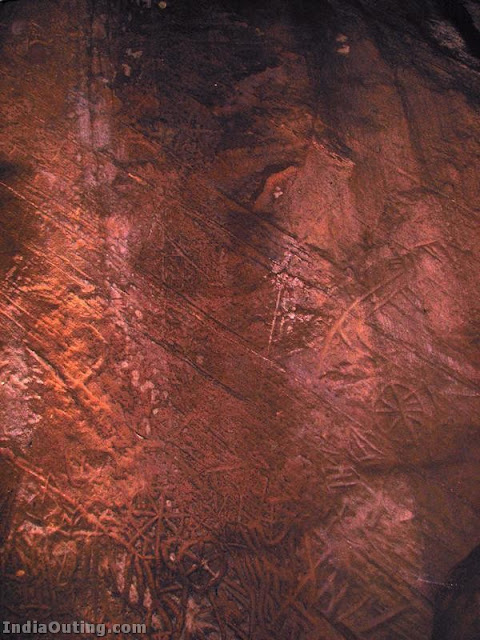

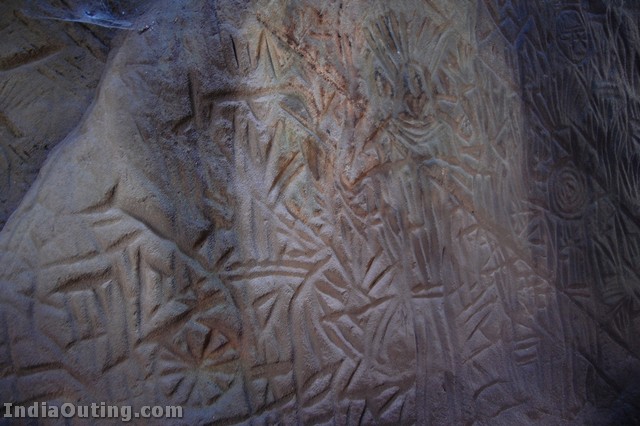

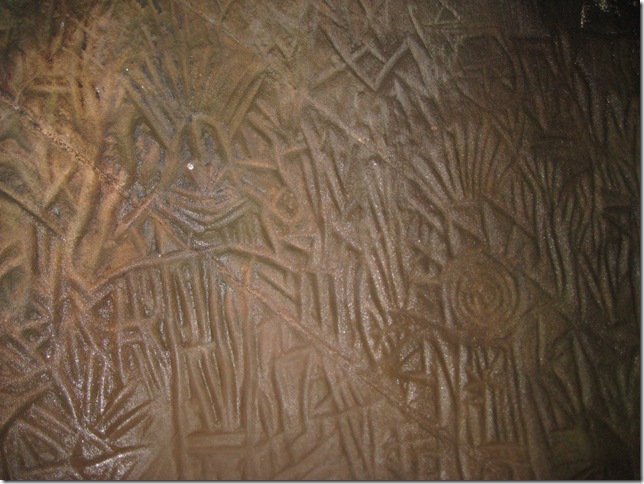



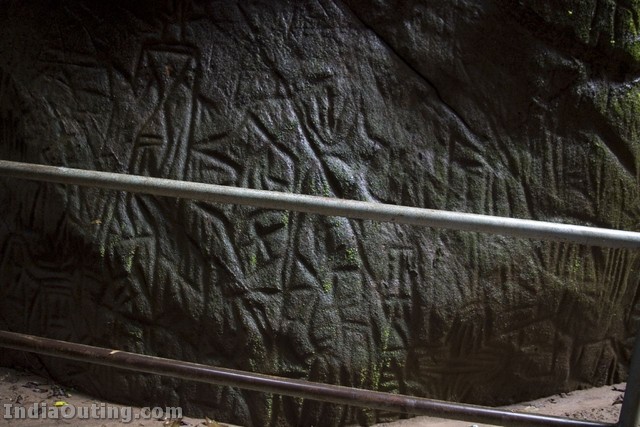
 

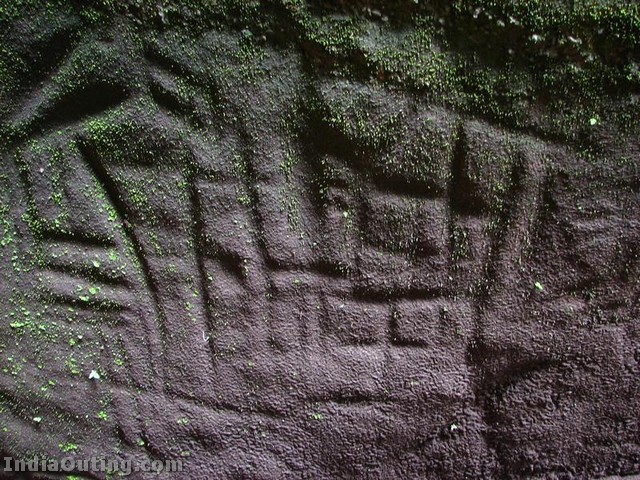

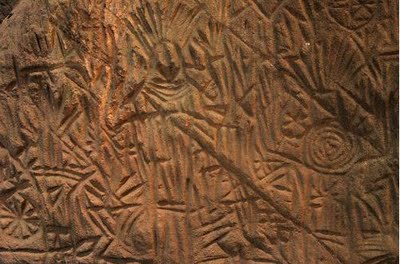

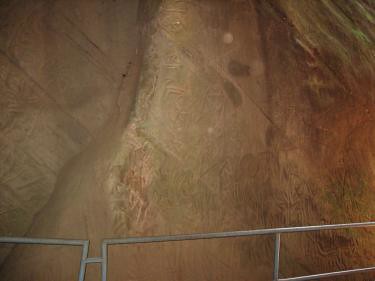




A rock engraving, indicating clear remnants of Harappan
culture
The
petroglyphs inside the cave are of at least three distinct
types. The oldest may date back over 8000 years ago. Evidence
indicates that the Edakkal caves had been inhabited at several
different times in history.[3]
The caves were accidentally discovered by Fred Fawcett in 1890
who immediately understood their anthropological and historical
importance. He subsequently wrote an article about them, attracting
the attention of scholars.[4]
[edit]
Tourism
information
Approximate time required to climb till top of the hill and down:
3-4 hours.
Entry to the hill closes by 4 PM.
Departmental jeeps can be hired to travel the initial few km till
the foot of the hill. A jeep can carry up to six passengers and
there are separate rates for one way and return journeys.
OOther nearby places - Soojippara water falls, Sultan Bathery,
Mutanga Wildlife Sanctuary.
[edit]
See also
Notes
[edit]
External links
|
AND NOW CONTINUE READING ABOUT /strong> |
Indus Valley Civilization
From
Wikipedia, the free on-line Encyclopedia
|

......NOTE OF
GREAT IMPORANTANCE OF
FOR CONTINUING SEARCH FOR TRUE KNOWLEDGE.....
Please note
that the extent of Indus Valley Civilization shown in the above map is
based on currently available archeological information....and as this
information increases as is proved by archeological discovery in Kerala
(today's news story) ultimately it is likely to be proved that Indus
Valley Civilization also called Harappan Civilization was alive in the
entire Indian subcontinent and its influence extended to many lands
around it and possibly up to Turkey, Africa, China and southeast Asia as
archeological discoveries and deciphering of the writings of that era
and relation to vEDik sNskRUt
and vED texts in all
these lands point to socio-economic-cultural ties.....
(Note from Champaklal Dajibhai Mistry
of Edmonton, Alberta, Canada who requested PVAF to publish
today's news story...)
&
|
PLEASE CONTINUE READING THIS
OVERVIEW OF br />
THE CURRENTLY KNOWN KNOWLEGE
INDUS VALLEY CIVILIZTION br />
BY CLICKING
HERE
(While reading
this please keep the note at the start of this page in your mind that
this knowledge could not only become redundant through coming
discoveries in the same as as what has happened to the "Aryan"
misinformation....) |
| |
|
There are 0 additional comments.
Send your news items
to be posted to news@prajapati-samaj.ca.
|

